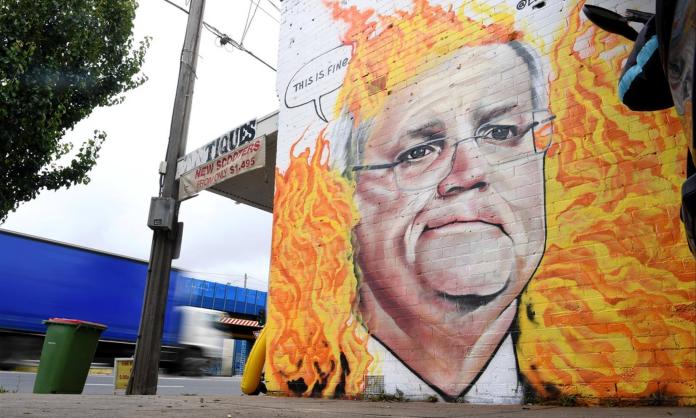Australia is among the world’s worst climate criminals, and Scott Morrison’s plan for a “gas-fired recovery” will cement this status for decades to come. If Morrison were an arsonist who, on the hottest summer days, travelled the countryside setting fires, it would be less of a crime. Bushfires threaten lives and communities in the areas that they burn. Morrison is threatening the future of our entire society.
The plan, which the PM outlined in a 15 September speech in the Hunter Valley, involves the government intervening to ensure that the gas industry continues to grow rapidly in the coming years. Australia is already among the world’s biggest gas producers and is the biggest exporter of liquefied natural gas—77.5 million tonnes of it last year, worth $50.5 billion.
Morrison appears to think he can get away with arguing that we need a new gas boom because there is a shortage of gas available for domestic consumption. “Cheaper, more abundant gas”, he said, “is the second pillar of our energy plan for COVID recovery. We’ve got to get the gas”. The only reason we don’t already have cheap and abundant gas, however, is that Australia’s major gas companies make more money exporting it.
The government could fix this by mandating that a certain portion of gas produced in Australia be set aside for domestic use. It could have done this at any point in the past decade, a period during which Australian gas exports have increased by 350 percent.
Morrison said he will consider this. By holding off for so long, however, the government has already “won” on two counts. First, it has facilitated the record-breaking profits of Australia’s major gas exporters. Second, it has driven up gas prices and helped the same companies make the case for a further expansion of gas production to cater for domestic consumers. High gas prices, in other words, were always part of the plan.
The government aims to supercharge the expansion of Australia’s gas industry. It will do this by lending government support and potentially significant public funding to new gas projects and infrastructure around the country. According to Morrison: “We need to accelerate development of new basins like the Beetaloo in the Northern Territory and Narrabri in New South Wales. As well as open up more development in existing basins in Queensland where substantial reserves remain untouched”.
Also on the government’s agenda are major new pipelines to connect gas fields to a proposed gas trading hub at Wallumbilla in Queensland. Finally, Morrison flagged the possibility that, if the private sector failed to invest in sufficient “dispatchable” (i.e. not intermittent like wind or solar) energy generation capacity over the next few years, the government would itself step in via Snowy Hydro to build a new gas-fired power station in the Hunter Valley.
Morrison and his fellow fossil fuel enthusiasts have embraced gas as a supposedly cleaner alternative to coal that can help the world transition to lower emissions. “There is no credible energy transition plan for an economy like Australia”, he argues, “that does not involve greater use of gas”. The “transition” part, however, is no more than window-dressing. By doubling down on Australia’s status as a global gas superpower, Morrison’s plan will delay the shift to renewables that we desperately need.
Gas is also far from being the clean alternative to coal its advocates say it is. Numerous studies have shown that so-called fugitive methane emissions from the mining and transportation of gas are much higher than admitted by the industry or government regulators. A 2018 study published in the journal Science examined emissions from US oil and natural gas production and found that methane leakage was 60 percent higher than estimated by the US Environmental Protection Agency.
Over twenty years in the atmosphere, methane is around 80 times more potent as a driver of warming than an equivalent volume of carbon dioxide. Concentrations of methane in the atmosphere are rising at a record pace, and Morrison’s plan will contribute to further rises in the years ahead.
Australia, then, is putting another nail in the coffin of efforts to keep warming to anywhere near the 1.5 degrees that many scientists consider the safe limit. It’s not just emissions from the domestic production and consumption of gas that matter. The massive volume of gas that Australia ships around the world contributes to global emissions no matter where it ends up being burned.
Morrison’s decision to pursue a “gas-fired recovery” for Australia will, in addition, encourage other countries with large untapped reserves of gas to do the same. In the cutthroat world of global capitalist competition, you can guarantee that if one country is enjoying a profit windfall from the exploitation of certain resources, those similarly endowed will quickly follow.
Further, if governments in major gas-producing countries such as Australia step in to increase production, it’s likely to lock in low global gas prices for years to come, which will encourage major consumers of gas—electricity generators, manufacturers and so on—to extend their use of it, instead of making the investments needed to transition to more sustainable alternatives. And as industry grows, particularly in developing countries, so too will the demand for gas, and the greenhouse emissions arising from its production and consumption.
For Morrison, of course, this is exactly the point. He wants to prolong Australia’s, and the world’s, reliance on gas in order to future-proof the profits of a fossil fuel industry that would be threatened by any serious action to reduce global emissions. And, unfortunately, the Labor Party is no better. In a draft party platform quoted in the Guardian, the ALP all but gives its full backing to Morrison’s plan, saying: “Labor supports the responsible development of Australia’s gas reserves ... including gas from coal seams, shale and tight gas formations”.
Astonishingly, despite last summer’s unprecedented bushfire catastrophe, the prospect of serious action on climate change seems as far away as ever. In the context of the pandemic, many on the left have raised the hopeful slogan “build back better”. The recovery our political leaders appear set on, however, is one in which we double down on the most destructive aspects of the status quo. If we let them get away with it, our future will be bleak.









